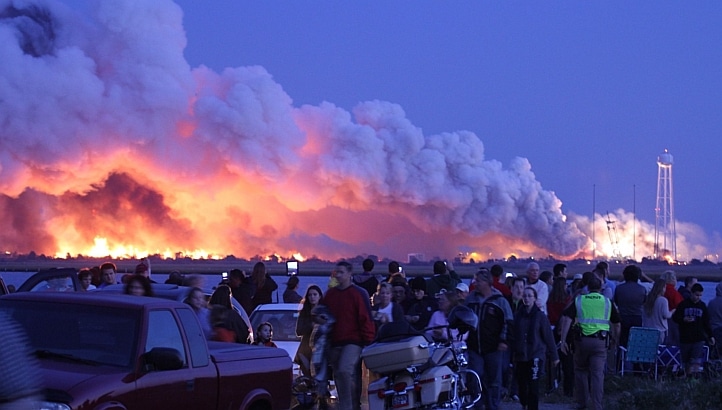Aerospace
NASA Space Rocket Explodes while Launching, Virginia

An unmanned commercial rocket headed for the International Space Station to deliver supplies exploded just after launching Tuesday, filling the sky with a massive fireball. The Antares rocket supplied by contractor Orbital Sciences blew up moments after liftoff at NASA‘s space launch facility on the Eastern Shore of Virginia, the space agency said. The explosion destroyed the rocket and spacecraft and immediately raised questions about the future of NASA’s reliance on private commercial ventures to carry vital payloads into space to supply and support the orbiting space station. NASA and Orbital Sciences were gathering data to determine the cause of the failure of the Orbital CRS-3, the space agency said. No injuries were reported.
The launch vehicle, dubbed Antares, exploded at the Mid-Atlantic Regional Spaceport at NASA’s Wallops Island Flight Facility in Virginia after takeoff at 3:22 p.m. PT.
No personnel were in the area and only the launch site suffered damage from the explosion, NASA confirmed. A 1,400 square-mile launch hazard area was cleared prior to liftoff in the event of a rocket failure.
The Antares rocket was made by Orbital Sciences Corp. and carried an Orbital-made Cygnus CRS-3 spacecraft ferrying about 5,000 pounds for resupplying the International Space Station, the heaviest payload to date for the Virginia-based rocket company. The spacecraft was supposed to dock with the ISS on November 2, when the six-person crew of Expedition 41 was to unload the supplies.
Orbital has a $1.9 billion contract with NASA, signed in 2008, as part of the organization’s Commercial Orbital Transportation Services. Today’s launch would have marked the third Orbital cargo mission out of a total of eight launches under its NASA contract. Orbital has supplied NASA with launch vehicles for more than two decades with its Pegasus and Minotaur rockets, many iterations of which have 100 percent launch success records.
Orbital Sciences is contracted to conduct eight supply missions delivering 20 tons of material to the space station.NASA said engineers from Orbital Sciences were not “tracking any issues” before the launch. NASA said it is investigating the crash and collecting all telemetry and other data, along with the contractor. The National Transportation Safety Board is monitoring, NASA said
The launch had already been delayed once after a sailboat entered its range on Monday night. Tuesday brought good launch weather, with clear skies and light winds.To guard against the dangers of a failed launch the Nasa facility maintains a hazard area of about 1,400 square miles around the site. Orbital said parts of the mission were covered by insurance and the rocket alone had been worth $200m.
The company has a $1.9bn contract with Nasa to make eight missions to ferry supplies to the space station and would have completed its third delivery with this launch. Since the US space agency retired its shuttle fleet in 2011 it has relied on private companies and co-operation with Russia for its missions into space.
Orbital said the spacecraft suffered a “catastrophic failure” at 6.22pm ET. “It is far too early to know the details of what happened,” said Culbertson in an initial statement. “As we begin to gather information our primary concern lies with the ongoing safety and security of those involved in our response and recovery operations. We will conduct a thorough investigation immediately to determine the cause of this failure and what steps can be taken to avoid a repeat of this incident.
Among the cargo were more than a dozen student research projects, including an experiment from students at Duchesne Academy of the Sacred Heart in Houston to test the performance of pea shoot growth in space. NASA is paying the Virginia-based Orbital Sciences and the California-based SpaceX company to keep the space station stocked in the post-shuttle era. This is the first disaster in that effort.
Courtesy : NASA Space station, The Guardian, USA today.

Aerospace
When Ratan Tata was denied entry to the airfield at the Aero India show, he waited

During our visit to Aero India 2019, we had the unexpected opportunity to see Ratan Tata at the event, which was a thrilling moment for us. However, there was a surprising hiccup when the security staff didn’t allow him to enter due to a lack of a security pass.
Despite this, he remained calm and patiently waited for about 20 minutes until a member of the Tata team brought him the required pass, after which he calmly proceeded inside. It was a humbling sight, showcasing his composed demeanor even in such situations.
Ratan Tata ji is not only a renowned industrialist but also a trained pilot, holding a pilot’s license. In 2007, he became the first Indian civilian to fly the F-16 Falcon during the Aero India show in Bangalore—a proud moment for the nation.
His passion for aviation extended beyond flying, as he played a key role in shaping India’s aerospace industry. Under his leadership, Tata ventured into manufacturing and maintaining aerospace components while upholding its legacy of quality. Notably, Tata’s collaboration with Airbus to develop and manufacture the C295 aircraft is a testament to its growing influence in the sector.
-

 Aviation2 months ago
Aviation2 months agoMicrosoft Flight Simulator Raises $3 Million to Bring Back the An-225 Mriya
-

 Airlines2 months ago
Airlines2 months agoQatar Citizens Can Travel to the United States Without a Visa
-

 Aviation2 months ago
Aviation2 months agoQatar Airways bans these new Electronic Devices on plane
-

 Defence2 months ago
Defence2 months agoWhich Country Has the Largest Fleet of Fighter Aircraft?
-

 Airlines1 week ago
Airlines1 week agoDAMAC Air: Dubai’s New Luxury Airline Offers Free Flights for Registration
-

 Airport2 months ago
Airport2 months agoWestern Sydney Airport Welcomes Its First Plane After 6 Years of construction
-

 Airlines6 days ago
Airlines6 days agoAir India to Launch aircraft maintenance training institute in Bengaluru
-

 Aviation2 months ago
Aviation2 months agoDid you know ? Once Boeing 747 carried 1088 passenger in 1991








